Beyond The Lens: Interview with Untamed Photographer's Filipe DeAndrade
"As a photographer, it's my job to communicate the stories of the natural world and to use animals as the storytellers for nature." -Filipe DeAndrade
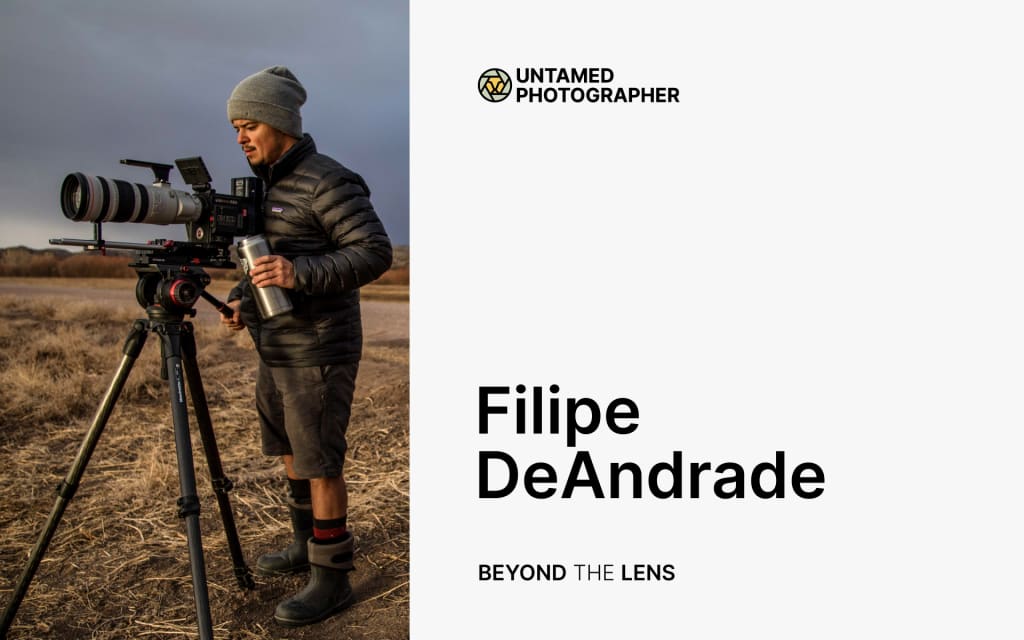
Filipe DeAndrade is a thrill-seeking, deep-diving, and Emmy-winning wildlife photographer and filmmaker. Born in the favelas of Rio de Janeiro, Brazil, an impoverished yet culturally-rich community located at the city's edge, the outspoken conservationist has maintained an intimate relationship with nature throughout every year of his young life.
A graduate of film production from the University of Florida, Filipe has earned and experienced an impressive level of success—especially considering his journey. As the child of a single mother fighting to provide for her family in the slums of Brazil, he wasn't supposed to become one of the most sought after camera operators in the wildlife filmmaking industry. As an undocumented immigrant living in Cleveland, Ohio, Filipe wasn't destined to win Nat Geo WILD's "Wild to Inspire" film competition fresh out of college—but he did. Despite his disadvantaged upbringing and all things considered, Filipe now finds himself with 10 Emmys (from 20 nominations) in his trophy case as a world-renowned producer and cinematographer.
Filipe continues to define his own path by allowing his unwavering love and appreciation for wildlife to lead the way. This respect for nature led him to co-found his own production house, become a Nat Geo Explorer, partner with industry behemoths like Disney and Netflix (amongst many other impactful nonprofits, like Untamed Photographer), and co-found his own NGO, "Worth More Alive."
While his accolades and partnerships suggest he's a veteran of his craft, Filipe believes his journey is just getting started. So, it's our hope that this #BeyondTheLens interview serves as merely a timestamp or checkpoint on his continued climb to a more eco-conscious future. In partnership with Untamed Photographer: Filipe DeAndrade, everybody.
On His Background and Providing a Voice for Nature:
I was born in the favelas of Rio de Janeiro, Brazil, pretty much at a chicken coop. Had to bite off my own umbilical cord... The first chapter was an interesting one for sure, but we got displaced and that’s how we ended up in the favelas.
Growing up as a kid with a single mom in one of the hardest places in the world to make it led to some challenging times; but, you don't exactly understand your circumstances as a kid. I had no idea that I was dirt poor because I had what everybody else had, and I was in one of the most charismatic and vibrant cities in the world.
I think I’ve been able to hold onto that energy coursing through my veins from an early age—what it means to be Brazilian, even though I grew up in Cleveland, Ohio (not exactly sister cities). Although I sound American, I probably look American, and my culture is fluent American, I'm just as much Brazilian at heart. That’s where I think my infectious passion for all things life and nature comes from.
You’ve got to factor in that Rio de Janeiro is probably one of the most contrasting cities, if not the most contrasting city in the world. Here, you have this giant statue of Christ in one of the most notorious ghettos in the world, but then you also have one of the harshest cement jungles overlooking a tropical paradise. All things considered, like the ocean, seamounts, and jungle, Brazil is one of the most diverse countries in the world in terms of culture and wildlife.
Growing up not too far from the Amazon jungle, the jaguar was my boogieman. It wasn't the neighbor, it wasn't an uncle, it wasn't some creepy person from down the street. The jaguar was what I feared growing up because it was what every Brazilian feared. When nights settled, we wouldn't go too far away from home—the jaguar might have taken you.
4 years in a row I've either ended or began the year alongside the Jaguar. This animal has taught me more about life than any other wild creature. The most important lesson: Fear. Fear exists to keep us alive.
I think learning to challenge my fears, then learning to harness that fear and turn it into a curiosity allowed that curiosity to bloom into a beautiful love story. The jaguar became my favorite animal in the world. I owe that to my Brazilian heritage, to my roots, and Rio de Janeiro. Being an illegal immigrant in Cleveland just solidified and cemented my need to lean into what my unique individual story was.
All my life, I challenged fears with being an outsider and, seemingly, not having a voice; so naturally, I was able to relate to things that don't have an obvious voice. Oftentimes we say, "animals don't have voices," but it's not that they don't have voices—it's that we're not hearing them because we have a communication problem.
As a photographer, it's my job to communicate the stories of the natural world and to use animals as the storytellers for nature. When they can communicate their story, we can understand and actually give a shit. Again, I owe that perspective to my upbringing and the challenges I've gone through as a kid between Cleveland, Ohio and Rio de Janeiro. By chance, I’ve been perfectly situated to help tell the stories of nature and wildlife.
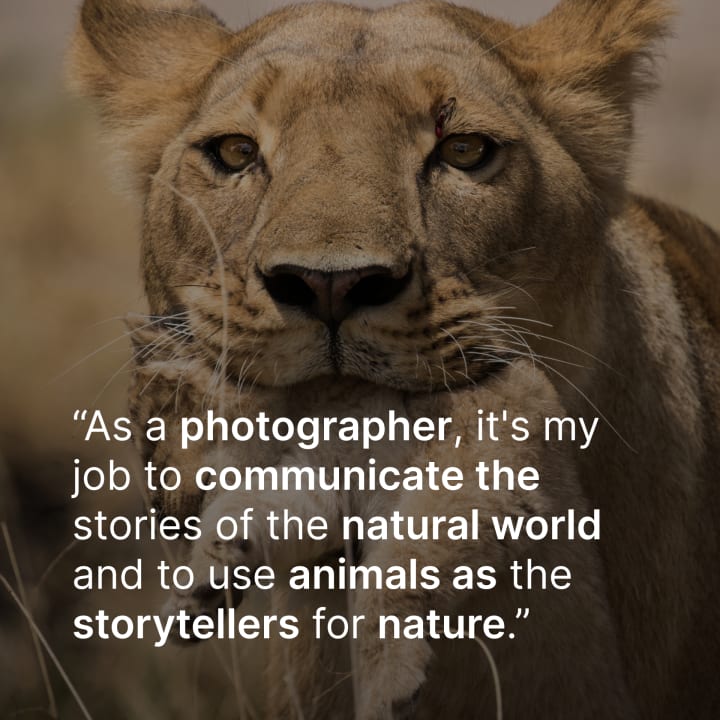
On His Affiliation with Untamed Photographer:
Untamed, that's a great word for me. That was also the name of a Nat Geo series I worked on. I also did a special Nat Geo film called "Untamed: Costa Rica". Untamed in its very essence, embodies who I am—not just as a photographer, but as an individual. I don't like walls. I don't like being boxed into anything. I like the idea of exploring, of diving, not just ‘helicopter-ing’ into a situation, but literally diving into a circumstance and understanding all the threats—all the possibilities on both the animal and human side. Untamed Photographer as a platform has been great because it's captured who I am as an individual; and that all starts with my relationship with their founder, Mark Wilkins.
I like to do business with friends, and Mark is somebody that I can really connect with. Our favorite animal is the jaguar, we both love sharks. We both love dark spaces because I think we'd rather light a candle than curse the darkness. In conservation, there're so many challenges, but with those challenges come opportunities. Mark and I really like to define our work through our accomplishments and through our abilities to inspire environmental change for the better.
Capturing prints, selling them, and having that money go towards caring for these animals and the individuals they’re working with is exactly what I wanted to do with my photography, and that’s exactly what Mark wants to do as the founder of Untamed. It was just a perfect, perfect fit.
On Discovering His Passion for Photography:
Photographing things helps me to understand them, and when I understand things I can fall in love with them and be better equipped to protect them. As a kid, I remember very specifically being 12 years old and my mom, who worked at a thrift store making $7 an hour under the table, buying me my first camera.
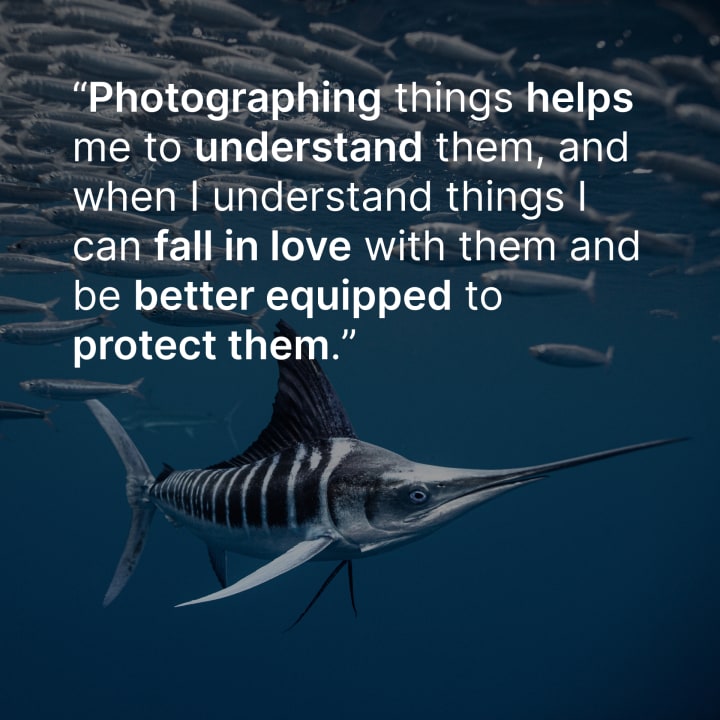
When I went to the Cleveland Metroparks Zoo, that's when I would say the greatest love story in my life started—not just when I got this camera, but when I could point this camera at animals.
I don't know if it's an oversimplification, but for me, no matter where I go, I can’t not bring a camera. You can ask anybody—I can’t take a bath without the fear that I might miss something. I can't go anywhere without it. Even when my girlfriend and I do things, when I do things with friends, I have to have it on me. The camera, for me, is an extension of how I feel about things. When you put a camera in somebody's hands, you find out what they care about.
Presence... the state or fact of existing, occurring, or being present in a place or thing. Photo by @brianmoghari of me with a beautiful Mako.
At the ripe age of 12, having my very first camera and going to the Cleveland Metroparks Zoo, and specifically finding my way to the rainforest, I’d literally get lost to the point where they had to call my name on the PA system, "Fil DeAndrade, your mom is looking for you. Be here at..." Literal hours went by. My mom was super pissed at me when she found me and was like, [paraphrasing] "I thought I lost you. We already have all these things going on in our lives, you can't add this shit to the table."
I didn't want to be found because I was afraid that the experience might end. It was the first time I found that I could lose myself in my environment, and I wasn't the son of the single mom or an illegal immigrant that felt out of place and out of mind everywhere I went—I felt at home. The rainforest section of this Metroparks Zoo was the closest thing that reminded me of home and being back in Brazil.
My passion for photography and for storytelling started when I was 12 when I got my first camera and saw I could illuminate people's curiosities with the things that mattered to me. The camera really was an extension of myself and animals became my subjects. While animals are the worst actors in the world (they never show up on time, and when they finally do, they want to eat each other), they make you feel like a part of the world. When you can let go of your ego and what you think nature is, it reveals itself to you.
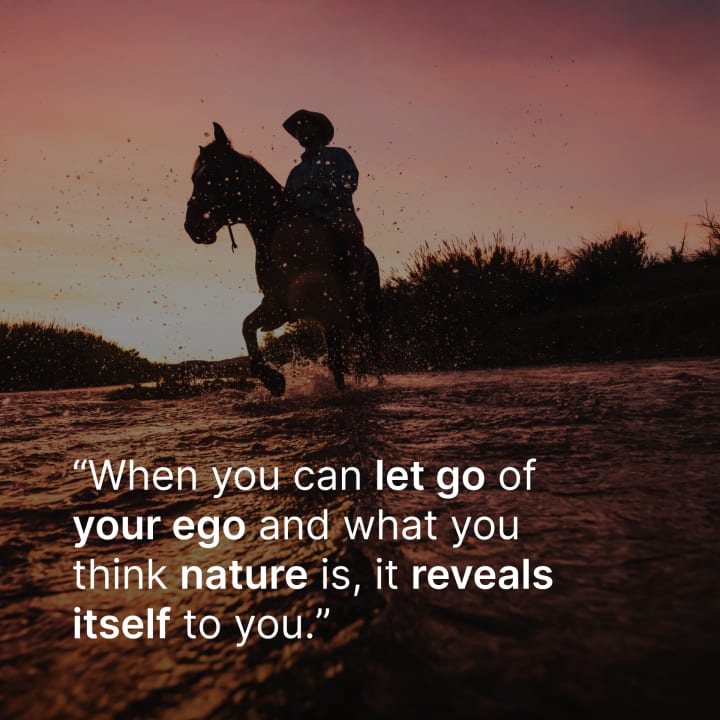
I learned that lesson very early on. If I was going to capture the greatest moments, if I was going to tell amazing stories, especially for somebody who's super ADHD and can't sit still (I mean, I'm literally pacing with the laptop in my hands right now. It's better that the camera's off.), I found passion to be what would encourage patience out of me.
I remember very specifically sitting in front of the crocodile exhibit at the rainforest side waiting for hours while people came up and said, "Oh, crocodiles are boring. They don't do anything," or they sat there for five minutes tapping on the glass, and then they would leave. I sat there for over two hours when I saw my first crocodile in the exhibit and just looked at it. Then finally, this thing pinpointed me, came over, and we just sat there staring at each other.
We were on opposite sides of the glass, and I was filming every single detail. The eyeball, the nictitating membrane, the scales, the teeth when it opened its mouth—I found it all overly fascinating. Like, holy shit, there's probably been a thousand human beings that have ran through that room— none of whom were as exciting to me as this crocodile sitting in an enclosure. I find nature fascinating and photography allows me to understand nature in a way that I could never on my own.
I photograph to understand. Understanding helps me care, and caring empowers me to protect.
On How Often He Shoots and Finding "Home" in Far Away Places:
Oof, I've spent twenty-eight days at home this year and even less last year. It's never a matter of how little I'm home though, it's a matter of feeling at home in the world wherever I'm at. Something I've been able to do incredibly well is making myself at home in any circumstance. Whether I'm in a cartel-run fishing community trying to photograph the finning of sharks, or I'm in Ethiopia’s Simien Mountains at 14,000 feet, Africa's roof, photographing gelada monkeys in a troop of 600 animals, or having coffee with the former president of Costa Rica in a cloud forest at 10,000 feet talking about how to inspire the next generation of young conservationists, I would say my greatest ability is to feel at home in any circumstance, which is a result of how little time I actually spend at home.
Gelada Monkeys, also known as "Bleeding Heart Monkeys" are one of the most striking primates in the world. They are as beautiful as the land that surrounds them, the Simien Mountains...Africa's roof.
Come to think of it, that's even more of a result of my background as someone who never had a home. Growing up, we never lived anywhere for more than two years. Whether we were kicked out for me doing something stupid like lighting something on fire, not being able to make rent, etc., we always found ourselves moving to the next place. How I am today is a direct result of my fleeting understanding of home.
On His Most Memorable Photo Expedition:
Not to sound cheesy, but my most memorable trip is the next one. I'm always thinking about what’s around the corner. I'm always thinking about opportunities that are ahead. I've been fortunate to see the world the way that I have.
But to answer the question more directly, I would say the most incredible trip I've taken recently has been to the most remote, far off corners of Baja, Mexico—places that don't get service, places that aren't on Google Maps. I came face to face with communities that drastically depend on nature in order to survive. Seeing how a changing planet is directly impacting people that don't have Facebook, Instagram, or platforms and major publications was heartbreaking. They don't get a chance to share how things like climate change, receding coastlines, mangrove degradation, reduced fish stocks because of overfishing, or the killing of critically important species are leading to real human suffering and directly impacting quality of life on an everyday basis.
That’s been the most intense and visceral experience I've had recently—just my general exposure to communities in the remote far corners of Baja, Mexico.
On His Most Negative Experiences While Shooting:
Well, when I was interviewing Cyndi Lauper in her New York apartment, she told me that I couldn't film her neck—so that was quite the challenge. I had to make her a floating head. It took some real lighting skills. On top of that, she had a dog that wouldn't stop barking. Then the manager let it go and it came over to me and started biting my ankles as I was filming her.
That was probably the hardest struggle I’ve had with a subject—trying to make Cyndi Lauper look good as a floating head and then getting bit in the ankles by her dog. I know that's probably not the answer you were looking for asking a wildlife photographer, though.
In all seriousness, for me as a photographer, I’ve never been in a bad or crazy situation where I felt like I was out of control. On a separate note, I've had some pretty insane things happen; like stepping off of a boat taxi onto the head of a stingray, getting stung in the foot, passing out on the beach, and having to be carried to a clinic for treatment. The clinic's power went out and so I had to use my cell phone as a flashlight while the surgeon cleaned out my foot from this disgusting infection. I still have a scar bigger than an inch to remind me of that.
What's the point of living in fear? I do the "craziest things" and almost got long-term injured doing something "normal." Even as I laid in the back of my truck (because the clinic lost power and kicked me out (small village)), I had the biggest smile on my face thinking about these last few slices of life pie.
Yeah, there were the not-so-delicious pieces; but I've swam with whales, dolphins, sharks, rays, witnessed new life bless our oceans, and have been consumed by great company and the energy of Costa Rican bliss. The last photo is of me with close friends enjoying dinner in the rain.
I love my life, even through the tough times. It's not always easy... but damn is it worth it.
I've also had instances where I was filming jaguars and a flood hit. In this remote part of the world, I had to go in the flood to retrieve the trap cameras because each unit was over $10,000, but they were surrounded by crocodiles. I had to walk into waist deep crocodile-abundant water with a tripod having to gently nudge crocodiles out of the way so I could retrieve these cameras.
I've also been held up at airports for people thinking that I was a spy, and ultimately not being let into countries. We’ve been in car crashes where we had to camp overnight in the middle of nowhere and learn how to change a spare on the cliffside of a mountain. I've had a norovirus disease which basically just cleans you out from every, every, every hole in your body. I was hugging a tree crying, throwing up, and shitting myself in the middle of nowhere in the woods—I think I lost like 20 pounds in a week. Something really disgusting that I wouldn't want to wish on anyone.
But animal-related, not too much. I've been bitten by a person on a subway train in New York for asking to take their photo. I've had tens of thousands of dollars worth of gear stolen both in the States and in other countries. A camera that didn't even hit the market yet was stolen from my car, so I had to tell the manufacturer, "hey, sorry... shit happens." I've had gear go down underwater, gear go down top side, drones crash while trying to land on our boat while filming whales in the middle of nowhere and slicing my producer's finger. She had to go in and have surgery in the middle of nowhere, the list is endless.
I’ve been held up at gunpoint. I've ran into people crossing drugs on the border of Mexico and the US. I ran into families illegally crossing and saw myself 15 years later on the border. I've seen it all.
On His Most Positive Run-In with a Subject:
My most positive run in with a subject was with a wild pod of dolphins off the coast of Turks and Caicos. I was spending time with a mom and calf every day for pretty much six weeks trying to document these animals for a Disney series, and after some time, gained the trust of the mom and caught details of their lives that I don't believe anybody else has seen or photographed.
Things like teaching how to hunt and feed, and literally having the mom drop her one-year-old calf with us near the boat as she went off to hunt, which was a sign that she clearly trusted us—she used us as a babysitter. Knowing that we would take care of her calf, she went out to provide for her baby and trusted us enough to know it would still be there when she got back. This allowed me to document intimate portraits and videos of their lives that I don’t think anybody else, at least for that specific group of individuals, was able to do.
One of those images is on Untamed Photographer, "Wild and Free". In that image, she's teaching the calf how to use its sonar to echolocate razorfish which bury themselves in the sand. The calf kept failing and pulling up shells or crabs or other things. That teaching moment was important for me to see. For her to allow me to get so close when they could have easily swam off was probably the most positive experience I can remember.
Bottlenose Dolphins, mom and calf, wild and free.
On His Affiliation with Project Coyote:
My work with Project Coyote is very much a collaboration. They're the NGO that's trying to end wildlife killing contests and offer protection to native carnivores like pumas, great wolves, coyotes, bobcats, foxes—the animals that society casts aside and sees as a problem. In reality though, I'm a firm believer, as are a lot of other biologists, scientists, and naturalists, that evolution is driven from the top down. We absolutely need predators in our ecosystems to keep balanced.
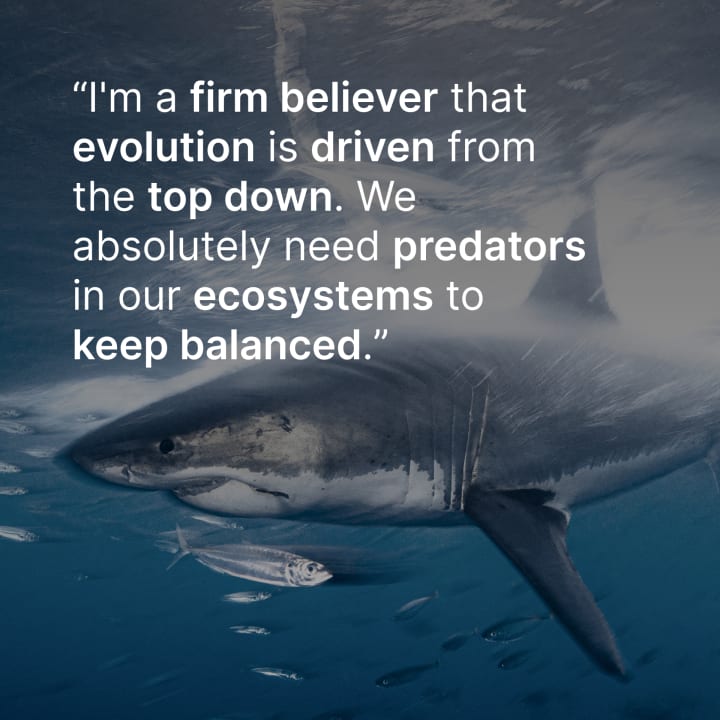
There's a reason that we have wolves, pumas, and jaguars—it's because they make every animal around them better. If you think about sharks, they've outlived the dinosaurs, they've been on the planet for over 450 million years. The very reason that prey species evolved the tactics and the skillsets that they have is to avoid from being eaten. It's why sharks and predators exist on the planet—to make the world a better place. Forcing animals and critters to evolve. That's something that I understand along with Project Coyote.
There's a very real hatred toward native predators in America right now. I would say that no animal better embodies this disconnect, and the fragile relationship that Americans specifically have with nature, than the wolf.
The very first wolf bounty was in 1630, and it was for a penny and the relationship hasn't changed much. This is an animal that used to roam over two million in the US, and now they're down to just over 6,000 and we consider that a victory.
Recently, I, along with other affiliated NGOs, have contributed our efforts to empower Project Coyote to write a lawsuit in Wisconsin and prevent the hunts from happening in November. This February, they overshot that quota by over a hundred, and then were given double the quota of animals to kill as a reward. It's something that's insane to me.
We learned to live alongside nature, and NGOs like Project Coyote, Humane Society, Defenders of Wildlife, Nakawe Project, Panthera, and Nature Trust of the Americas (NTOTA), represent a rewiring to nature. We need to learn to live alongside these animals—not just for their sake, but for our sake. If we kill off predators, if we kill off species and create an imbalance in nature, then we don't survive on this planet.
Conservation is the management of people, not land and animals. Those things will take care of themselves. The earth is four billion years old—it's figured it out long before us. Predators specifically deserve a place on our planet. That's the relationship that I have with Project Coyote. That's the message that we're trying to send to people.
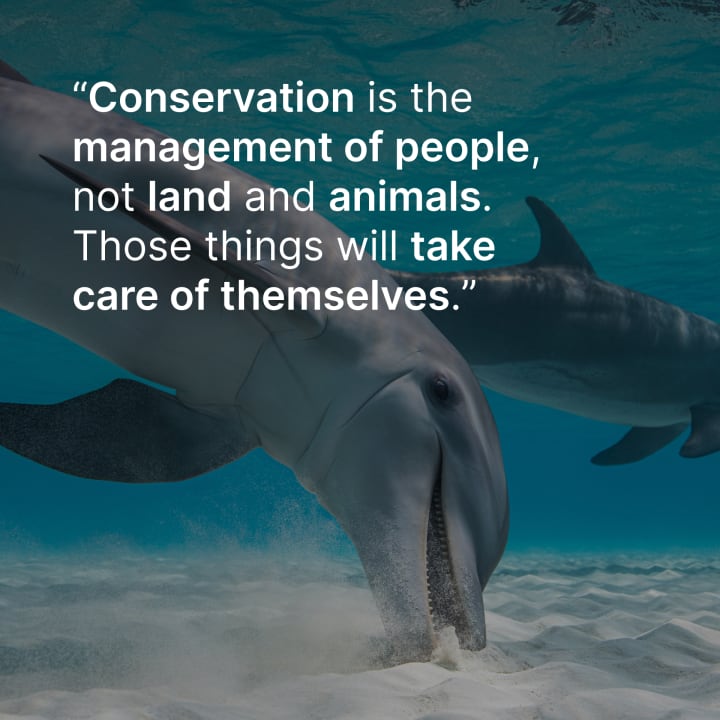
On “Wildlife Killing Contests”:
If you haven't heard of Wildlife Killing Contests yet, here's a quick rundown. They are indiscriminate sport killing tournaments disguised as "predator management." Not a single piece of scientific publication supports these as ecologically beneficial, appropriate tools for predator management and they go against every principle of ethical hunting.
These contests are happening in over 40 states. It's a really ugly secret in America, and it actually defies the North American model for conservation, which is the foundation of hunting in this country. A lot of hunters will separate themselves from things like this. It's not a matter of hunting, gun laws, or rights—it's actually a matter of preventing sport killing. The basis of these tournaments is to kill as many animals as possible and by any means necessary.
People will use calls, they'll hunt at night, they'll blind animals with lights; and again, it's not hunting, it's sport killing. Any ethical hunter will tell you that. Any person who’s partook in these contests, if they're an ethical hunter, they haven't done them again. If somebody continues to partake in these contests, they're just out for numbers and they’re out to win a trophy or prove something—which again, goes against conservation and goes against hunting.
To give you an idea of how prevalent they are, I went to a tournament one weekend in Texas. There were over 700 teams that signed up and one team killed over 120 animals. That's in one weekend, in one state, at one tournament. They're growing in numbers. They're absolutely against what conservation is and what hunting is. They're going to take over, destroy our connection with nature, and misrepresent how hunting can be used as a tool in this country. They absolutely 100% have to be stopped as soon as possible if we're going to work with hunters and use hunting as a conservation tool.
On His NGO "Worth More Alive":
I just recently got my 501(c)(3) status for an NGO that I've been looking to do for a long time with my business partner, Brian Moghari, who's also a contributor on Untamed Photographer.
The name of that NGO is “Worth More Alive.” We're basically trying to redefine how we place value on wildlife, because how we value wildlife determines the protection that we give to these animals.
Whales are our conservation story. When “The Song of the Whales” came out, I believe, in the '70s, it opened up people's minds and hearts to who animals are. It leveraged protection for these animals. I'm just really, without saying too much, trying to re-examine how we defined our relationship with humpback whales and how that can be used in this time in history to further the evolution of our relationship with these animals.
On the Longest He's Waited for a Shot:
I feel like I'll wait a lifetime for some of the shots that I have in my head. Time-wise, I would say I spent the greater part of a year researching, setting out trap cameras, trying to understand jaguars' movements, where they go, where they don't go, exactly what they're feeding on (not just on sea turtles), and also trying to understand unique individual stories through trap camera work and through going time and time again to areas where I knew they were frequenting. More specifically, I waited 21 days to get 10 minutes of a jaguar.
That became a documentary that I did for National Geographical called “Jaguar Beach,” and produced some of my favorite images, maybe not my best images, but my favorite images because of the time and the commitment that I put into documenting the jaguar. It also transpired into a deeper relationship with them, which has allowed me to film jaguars for Disney, Netflix, Arte, and also sit on the chair of a jaguar NGO, which is going to give deeper protection to these animals in Costa Rica.
On His Favorite Pieces of Equipment:
My favorite pieces of equipment that I own? Man, that might be my shoes and my wide angle lens.
My shoes have taken me all around this world and I really beat the hell out of those things. I got itchy feet, so I have to look after them. I'm constantly walking on glass, walking in mangroves, and walking in scorching heat, a lot of times in dunes in the middle of nowhere.
I feel like my shoes get me from point A to point B; and the ability to move, not just in a broader sense, like travel, but also when it comes to photography and film, because I like to get close to animals.
Intimate moments in nature are more difficult to come by than going to places that exploit animals, but they are genuine and beyond worth it.
I like to wedge myself in between their story and their environment to get intimate portraits; and so for me, a wide angle lens allows me to capture things like the breath of an animal and the eye of an animal on a level that most photographers maybe aren't willing to go to out of fear for their lives.
By understanding something like a jaguar, I was able to sit all of November ‘21 filming them for Netflix and witnessing them over 20 times on a beach. My shoes brought me literally five feet from a wild Jaguar as it was hunting on a remote beach. I was close enough to capture the fog of this animal on my wide angle lens as it was hunting. Again, my shoes get me to places where other people wouldn't be willing to go. My favorite pieces of equipment are those things that put me inside of an animal’s environment. Like hammerheads, for example, in a Nat Geo piece on sharks that I'm working on right now.
My favorite equipment gets me in places like 130 feet below the surface of the earth where you look up and the sun is blacked out by the amount of hammerheads; or in front of great white sharks as they're breaching to hunt in remote corners of Mexico; or inside of the environment of lions as they're hunting elephants in order to feed themselves during the heat of the dry season in the Okavango Delta. In short, I would say my shoes and my wide angle lens are my two favorite pieces of equipment.
On Overlooked Skills and Training Necessary to be a Wildlife Photographer:
I’d say the most impactful training that you can have is the ability to empathize and to communicate. When you take a sincere approach to photography, and what I mean by that is genuinely understanding people, their lives, their struggles, and their environment, people open up and introduce you to environments and animals that you never would have known about otherwise. A lot of times, photographers and naturalists, and this is something that I don't like about the industry (especially in filmmaking), when you point a camera at a wild animal doing a wild thing and you flip it 180 degrees and shoot the reverse, you're probably capturing human suffering. You're probably capturing overdevelopment. You're probably capturing what the real story is, which is the contrast of humans and nature.
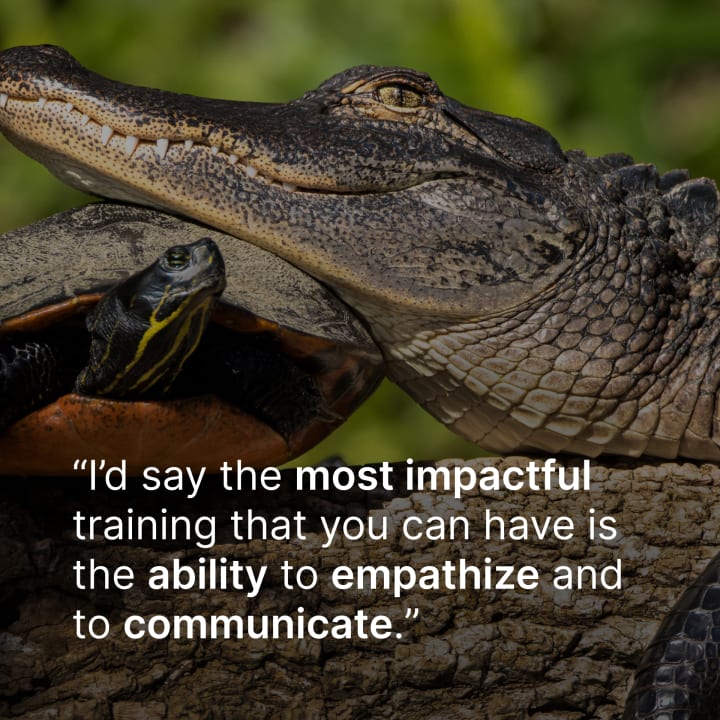
The ability to empathize and to communicate with people gets you to those stories. The real story in 2021 is man's relationship with nature and how we're de-evolving as our relationship with nature de-evolves. If you can empathize, if you can communicate, if you can take a sincere interest in people's lives and their unique stories, whether it be a biologist, a local, a fisherman, a landowner, they will introduce you to nature and to creatures in a way that would take you years if you didn't have that relationship with them.
The evolution of that is to ask more questions and make less statements. Something that I'm relearning every single day is humility, and sometimes when I think I know too much or I understand something, somebody with less in their bank account than me, but more in the bank of life experiences will remind me that I'm in their world. If I truly want to learn, I need to ask more questions instead of making more statements.
On Advice and Gear Recommendations for Aspiring Wildlife Photographers:
I wouldn’t recommend a phone to be honest with you. I know there's that statement out there, like the greatest camera’s the one in your hands; but honestly, I would put the phone down and grab whatever DSLR and fixed wide to medium portrait lens you could find. In my opinion, the greatest possible tool is the camera that you can afford and either a lens or several lenses that give you the ability to shoot wide, something like an 18 - 35 or 50, or a fixed wide-angle lens or 50-millimeter lens.
The reason being is that if you start off shooting telephotos, something like 400 millimeters or above, then you keep a safe distance away from your subjects. Whereas, if you start off shooting wide and intimate portraits in millimeter range, then it forces you to use your feet, to walk closer to people, to talk to people, to understand people and their connection to what it is that makes them tick or their heart sing. It forces you to build an intimate relationship with your subject, which for me, is the Jaguar. If I want to capture the best images, it's not through a 600, it's through an 18 millimeter or 16 millimeter, because it forces me to get close to that animal.
Or if I'm filming or photographing people, then it forces me to have a conversation with them. The phone is a great tool, it can be an amazing tool in a lot of circumstances, but it also provides a lot of distractions. When you take an image on the phone, it forces you immediately to think “how can I share this on Instagram?,” “how am I going to talk about this on Facebook?,” or “how am I going to talk to people about the experience I just had?” without dissecting and absorbing the experience you just had.
A lot of times, and this is something for younger people, I see them make the mistake of taking a picture and then immediately posting without absorbing what it means to them. By having a photo camera, kicking it old school a little bit (it doesn't have to be film, it can be DSLR or mirrorless), it helps you focus on the images you're capturing and allows you to experience the moment and build a relationship with your subject rather than using the phone. That usually leads to thinking about how you're going to tell the world about the experience you just had without actually understanding the experience you just had.
To all the beginners out there, grab a camera, one that you can afford (it doesn't have to be the best one) and get a wide-angle lens. That's the secret honestly. I like to shoot shallow. A lot of people will tell you a portrait lens is something between 35 and 50 millimeters, but here’s a secret that I don't just tell anyone:
For me, my portrait lens is a 15 millimeter at 2.8 and inside the world of my subject. Feel the breath on the lens and tell the story that a telephoto or a millimeter range that forces you to stand back wouldn't tell.
On His Team:
My best friend in the world who's also my business partner, who I met in college, who contrasts me in a lot of ways is Brian Moghari. He's an amazing creative, he's super talented, and he doesn't get enough respect and admiration for his talents in this world. He's not someone that really likes to put himself out there; but I feel like with Brian, I can accomplish anything in the world.
We have an amazing friendship. We've been doing this for over a decade now. We met in our super early 20s and are keeping it going. Brian’s my best friend, my business partner, my colleague, and a super talent that doesn't get enough recognition.
Sharing beef ravioli cooked over an open fire without pants on. I think @brianmoghari [and I] got this whole van life thing down.
Also my partner Regi Domingo, who is, in my opinion, the greatest living conservationist. She's insane, just an insane individual who throws herself into any circumstance—the crazier, the better. I love working with her. I love learning how to work with your partner. I think love and conservation proposes an interesting dilemma because there's not a lot of people that make it in this world.
Other than that, I like to bounce around with different creatives and learn. The team at Nakawe is amazing. The team at Beneath the Waves is great—they're all great, really.
I also love to partner with people like Mark Wilkins, who has a lot of resources and can make things happen for creatives. He can empower people and he sees their vision and where they want to go and can help them get there.
On His Next Steps and Ultimate Goals:
A lot of people, networks, producers, etc. keep telling me that I need to focus. They say that if I hadn’t mixed it up so much I’d be a lot further in my career; and it's probably the greatest criticism against me. They tell me to focus on one thing—whether it's jaguars, sharks, or the ocean, or whether I want to be a conservationist, photographer, or filmmaker. They tell me to pick one thing and stick to it.
I would say the reason I am the way I am right now is I have a very specific goal in mind; and I feel like the reason people want to box me is because what I want to accomplish hasn't been done before. I think that's a crazy thing to put out there, and it might come off as egotistical and self-centered; but, how it's taken is out of my control. I can't help how I feel, and I feel like I can see a thousand years down the road. We're continuing to make the same mistakes that we have already made. By learning from those mistakes, it allows me to prepare and to put myself in a position to succeed.
I have a three-year plan, and I have a five and ten-year plan too; but I would say my ten-year plan has moved up to a two-year plan, which is to combine the efforts I've made as a spokesperson for conservation.
My goal right now is to create a character of myself who is our generation's Jane Goodall, Sylvia Earle, or Steve Irwin. That's just based on our generation’s void of a conservation ambassador. I don't think we're getting the message straight from the source. I see a lot of paper gangsters, a lot of people that claim they're doing conservation and talk about saving animals, this, that, or the other; but really they're all about clout. They're building an empire that is bad for animals in nature, specifically talking about grabbing animals, doing animal selfies, having a relationship with nature that only furthers the individual. They’re using animals to further their name, rather than actually thinking about what's best for the animal. It's something that Instagram and social media in general has glorified.
If you look at the biggest conservation accounts right now on social media, it's not the Nat Geo explorers, it's not the conservationists or biologists doing the real work—it's the people glorifying animal selfies, and in return hurting animals and hurting the environment by creating a market to abuse wildlife solely for the sake of the human experience. That's what's been happening since social media popped off. I'm going—I'm not just saying I want to—but I'm going to change that.
I'm going to create a respect level for nature that benefits both humans and animals. I'm going to do that with messaging, social media, film, and collaboration with musicians, poets, writers, politicians, and even millionaires to share the natural experiences they've had and create a dynamic shift. If you're not appreciating nature, and you're not considering the best interest of the animals, then… I hate cancel culture, but you're not going to be accepted in our tribe of conservationists. These people are doing more harm than good, and they need to start getting called out for who they are if they're not willing to change and consider the benefit of the animals.
Throughout my career I’ve been building this house with different pillars: conservation, photography, spokesperson, Nat Geo live, brand ambassador for different camera companies, brand ambassador for different NGOs, etc. I'm going to combine all those efforts in my NGO, which is called “Worth More Alive,” to give other people who are doing amazing work a platform to become this generation's Sylvia Earle, Jane Goodall, or Steve Irwin because I think we need it now more than ever.
On Current Projects and Objectives:
I wouldn't be working on something that I wasn't excited about. Everything gets me going at this point.
In a general sense, something I'm really excited about is building on collaborations with individuals. I love my relationships with Disney, Netflix, and National Geographic and other major publications and platforms like Creatd; but I'm really excited to develop my professional relationships with individuals.
Something that’s coming up that I'm thrilled about is telling the story of scarlet macaws in Belize and how they can contribute greatly towards their national economy and cultural identity.
I don't know if I should be talking about it right now, but something I’m doing with Mark Wilkins is going into Belize and telling the story of the scarlet macaws, a cultural icon, and how it benefits not just their culture and their nature, but their economy. We aim to show others that if you remove this beautiful, all-important animal from the ecosystem, then you strip a very powerful tool for the Belizean people that can be used to protect their home.
Working on something that is critically important for the preservation of scarlet macaws. There are only around 300 left in all of Belize and we intend to grow that number. Everyday they face threats from poaching, deforestation, and wildlife exploitation. If we can't even save the eye-gasmic wonders of this planet, how do we expect to sustain a future for all living things on this planet?
On Which Untamed Photo He's Most Proud Of:
Again, not to have a cop-out answer, but if I wasn't proud of it, then it wouldn't be up there.
Don’t think about it—first thing that comes to mind:
What is one thing you couldn’t live without?
Passion
Favorite animal to photograph?
The one I’m photographing currently.
Favorite location to shoot?
The ocean
Least favorite location to shoot?
On a set
What would you do if you weren’t a photographer?
I’d be using a different tool to communicate love and passion for nature.
Favorite snack while shooting?
Chocolate. Even though it never keeps, it’s my go-to.
Go-to cafe order?
Grilled cheese, baby. Grilled cheese with tomatoes.
Favorite season?
Mating season
If you could speak with one type of animal, which animal would it be?
Humans. I would tell them that we’re fucking this thing up. This isn’t a save the planet campaign, it’s a save ourselves from ourselves campaign.
Favorite piece by another Wildlife Photographer?
My favorite photograph of all time is the image that Michael "Nick" Nichols took of Jane Goodall. She’s standing in front of a cage with a chimp, and puts her hair down so the chimp can reach out and feel it.
Favorite piece by another Untamed Photographer?
I have to give it up to my boy Brian Moghari with his photograph "Misunderstood Predators."
The hammerhead shark in the photo we endearingly know as "Pocahontas" from the Bahamas. I got to live it with him as he took that. Plus, he was using my camera set up, so I'd like to think that I had a little good juju emitting from that thing.
Hollywood films and news headlines tell us sharks are life threatening man- eaters, but statistically speaking this couldn’t be further from the truth. They are simply just misunderstood.
Closing:
Filipe, when we asked which current project you're most excited about and which photograph you're most proud of, you said you couldn't choose. How could you? It's not that simple, you explained. To you, that's like asking a parent which child they love the most; and even then, sometimes there's an obvious standout...
The passion you pour into your photography and film work is felt immediately by those who view it. Thank you for offering a way for animals to tell the stories of the natural world. These stories are compelling; they're what we need to understand their struggles, aspirations, and requests.
One of those requests? Supporting the causes, organizations, and individuals that are working constantly to protect our environment and all the critters who call it home.
Sometimes it's nice to feel like there's someone watching out for us, even when we feel like all hope is gone. You can be that someone for the millions of animals that are losing their homes every day by supporting the work of Untamed Photographers, like Filipe.
Shop Filipe's limited-edition wildlife prints
Untamed Photographer is an online art gallery that brings together wildlife photography and stories from a range of international environmental artists, both emerging and established.
Supporting Untamed Photographer means supporting projects like Nature Trust of The Americas, Nakawe Project, Project Coyote, and countless other NGOs who are inspiring real change in nature, conservation, and the greater protection of living things.
Also, be sure to check out our Beyond The Lens interviews with some of the other Untamed Photographers!
Tony Rath is a distinguished photojournalist and wildlife photographer who has spent the last 30+ years exploring and documenting the peaks and depths of Belize, a Caribbean country in Central America. Through his skills as a photographer and writer, Tony contributes to the efforts of many Belizean Non-Governmental Organizations (NGOs) in pursuit of charity, wildlife conservation, and environmental protection.
Chris Fallows is a strikingly passionate and accomplished wildlife photographer and naturalist. Best known for his discovery and ensuing depiction of breaching great white sharks in Seal Island, South Africa, the world-renowned photographer has seen his life's work featured on some of the biggest stages the industry has to offer.
Melissa Groo is a wildlife photographer, writer, and conservationist with a passion for educating people about the marvels of the natural world. She believes that photography can be both fine art and a powerful vehicle for storytelling, and considers herself a “wildlife biographer” as much as a wildlife photographer.




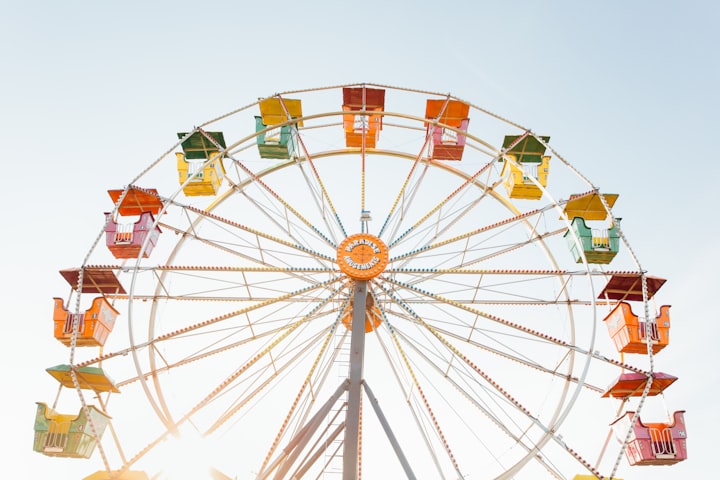


Comments
There are no comments for this story
Be the first to respond and start the conversation.